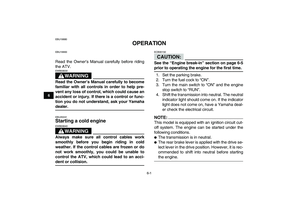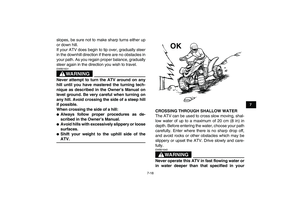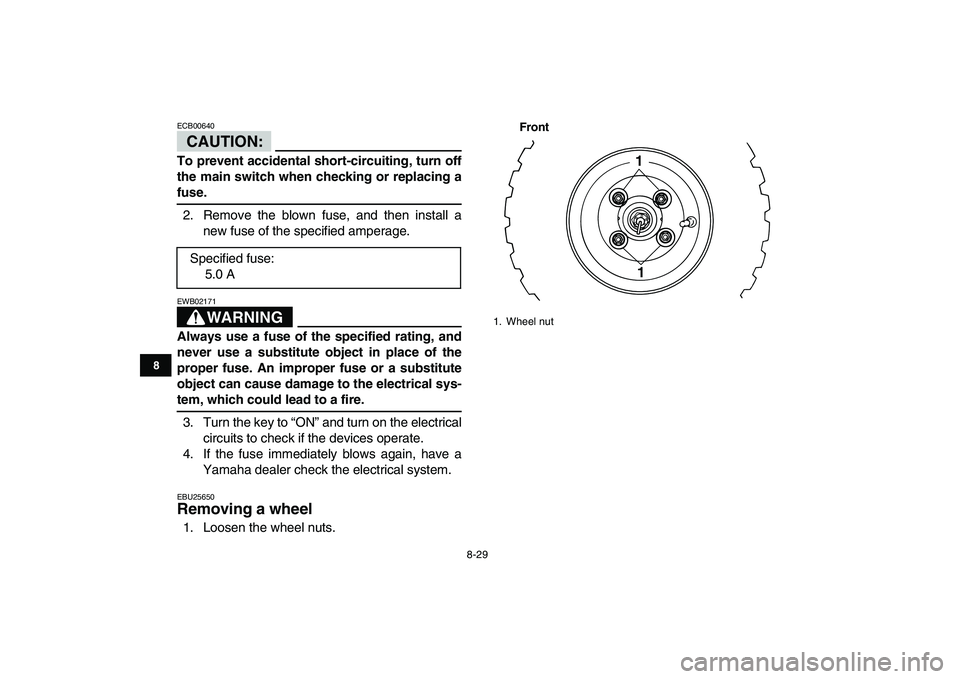Page 97 of 116

8-26
1
2
3
4
5
6
78
9
10
11
EBU25101
Lubricating the steering shaft
The steering shaft must be lubricated at the inter-
vals specified in the periodic maintenance and lu-
brication chart.
EBU25121
Battery
A poorly maintained battery will corrode and dis-
charge quickly. The electrolyte level, battery lead
connections and breather hose routing should be
checked before each ride and at the intervals
specified in the periodic maintenance and lubrica-
tion chart.
To check the electrolyte level
1. Place the ATV on a level surface.
2. Check the electrolyte level in the battery.
NOTE:
The electrolyte should be between the minimum
and maximum level marks.
3. If the electrolyte is at or below the minimumlevel mark, add distilled water to raise it to the
maximum level mark.
CAUTION:
ECB00590
Use only distilled water, as tap water contains
minerals that are harmful to the battery.
WARNING
EWB02160
Battery electrolyte is poisonous and danger-
ous, as it contains sulfuric acid, which can
cause severe burns. Avoid contact with skin,
Recommended lubricant:
Lithium-soap-based grease (all-purpose
grease)
1. Maximum level mark
2. Minimum level mark
1
2
Page 98 of 116

8-27
1
2
3
4
5
6
78
9
10
11
eyes or clothing. Always shield your eyes
when working near batteries.
Antidote:
EXTERNAL: Flush with water.
INTERNAL: Drink large quantities of water or
milk. Follow with milk of magnesia, beaten egg
or vegetable oil. Call a physician immediately.
EYES: Flush with water for 15 minutes and get
prompt medical attention.
Batteries produce explosive gases. Keep
sparks, flame, cigarettes or other sources of ig-
nition away. Ventilate when charging or using
in an enclosed space.
KEEP OUT OF REACH OF CHILDREN.
4. Check and, if necessary, tighten the battery
lead connections and correct the breather
hose routing.
To store the battery
If the ATV will not be used for more than one
month, the battery will need to be removed and
stored as follows.
1. Disconnect the negative lead first and then the
positive lead.2. Remove the battery, fully charge it, and then
place it in a cool, dry place.CAUTION:
ECB00600
Do not leave or store the battery on its side.
3. If the battery will be stored for more than two
months, check the specific gravity of the elec-
trolyte at least once a month and fully charge
the battery whenever necessary.
1. Battery
2. Negative battery lead (black)
3. Positive battery lead (red)
23
1
Page 99 of 116
8-28
1
2
3
4
5
6
78
9
10
11
To install the battery
NOTE:
Be sure the battery is fully charged.
1. Install the battery.
2. Connect the positive lead first, and then con-
nect the negative lead.
3. Make sure that the breather hose is properly
routed, in good condition, and not obstructed.
CAUTION:
ECB00610
If the breather hose is positioned in such a waythat the frame is exposed to electrolyte or gas
expelled from the battery, the frame could suf-
fer structural and external damages.
EBU25242
Replacing the fuse
The fuse holder is located under the seat. (See
page 4-11.)
If the fuse is blown, replace it as follows.
1. Turn the key to “OFF” and turn off all electrical
circuits.
1. Battery
2. Battery breather hose
1
2
1. Fuse
2. Spare fuse
1
2
Page 100 of 116
8-29
1
2
3
4
5
6
78
9
10
11
CAUTION:
ECB00640
To prevent accidental short-circuiting, turn off
the main switch when checking or replacing a
fuse.
2. Remove the blown fuse, and then install a
new fuse of the specified amperage.
WARNING
EWB02171
Always use a fuse of the specified rating, and
never use a substitute object in place of the
proper fuse. An improper fuse or a substitute
object can cause damage to the electrical sys-
tem, which could lead to a fire.
3. Turn the key to “ON” and turn on the electrical
circuits to check if the devices operate.
4. If the fuse immediately blows again, have a
Yamaha dealer check the electrical system.
EBU25650
Removing a wheel
1. Loosen the wheel nuts.
Front
Specified fuse:
5.0 A
1. Wheel nut
1
1
Page 101 of 116
8-30
1
2
3
4
5
6
78
9
10
11
Rear
2. Elevate the ATV and place a suitable stand
under the frame.
3. Remove the nuts from the wheel.
4. Remove the wheel.
EBU27480
Installing a wheel
1. Install the wheel and the nuts.
NOTE:
When installing the wheel, make sure its arrow
mark points toward the rotating direction of the
wheel.
Front
1. Wheel nut
1
1. Arrow mark
1
Page 102 of 116

8-31
1
2
3
4
5
6
78
9
10
11
Rear
2. Lower the ATV to the ground.
3. Tighten the wheel nuts to the specified
torques.
EBU25720
Troubleshooting
Although Yamaha ATVs receive a thorough in-
spection before shipment from the factory, trouble
may occur during operation. Any problem in the fu-
el, compression, or ignition systems, for example,
can cause poor starting and loss of power.
The following troubleshooting chart represents a
quick and easy procedure for checking these vital
systems yourself. However, should your ATV re-
quire any repair, take it to a Yamaha dealer, whose
skilled technicians have the necessary tools, expe-
rience, and know-how to service the ATV properly.
Use only genuine Yamaha replacement parts. Im-
itation parts may look like Yamaha parts, but they
are often inferior, have a shorter service life and
can lead to expensive repair bills.
WARNING
EWB02280
Do not smoke when checking the fuel system.
Fuel can ignite or explode, causing severe inju-
ry or property damage. Make sure there are no
open flames or sparks in the area, including pi-
lot lights from water heaters or furnaces.
1. Arrow mark
Tightening torques:
Front wheel nut:
28 Nm (2.8 m·kgf, 20 ft·lbf)
Rear wheel nut:
28 Nm (2.8 m·kgf, 20 ft·lbf)
1
Page 103 of 116
8-32
1
2
3
4
5
6
78
9
10
11
EBU25791
Troubleshooting chart
Check the fuel level in
the fuel tank.1. Fuel
There is enough fuel.
There is no fuel.
Check the compression.
Supply fuel.
The engine does not start.
Check the compression.
Operate the electric starter.2. Compression
There is compression.
There is no compression.
Check the ignition.
Have a Yamaha dealer
check the ATV.
Remove the spark plug
and check the electrodes.3. Ignition
Wipe off with a dry cloth and correct the
spark plug gap, or replace the spark plug.
Have a Yamaha dealer check the ATV.
The engine does not start.
Have a Yamaha dealer
check the ATV.
The engine does not start.
Check the battery.
Operate the electric starter.4. Battery
The engine turns over
quickly.
The engine turns over
slowly.
The battery is good.Check the electrolyte level, recharge the
battery and check the lead connections.
DryWet
Open the throttle halfway and operate
the electric starter.
Page 104 of 116

9-1
1
2
3
4
5
6
7
89
10
11
EBU25860
CLEANING AND STORAGE
EBU25880
Cleaning
Frequent, thorough cleaning of your ATV will not
only enhance its appearance but will improve its
general performance and extend the useful life of
many components.
1. Before cleaning the ATV:
a. Block off the end of the exhaust pipe to
prevent water entry. A plastic bag and
strong rubber band may be used.
b. Make sure the spark plug and all filler caps
are properly installed.
2. If the engine case is excessively greasy, apply
degreaser with a paint brush. Do not apply de-
greaser to the wheel axles.
3. Rinse the dirt and degreaser off with a garden
hose. Use only enough pressure to do the job.
CAUTION:
ECB00710
Excessive water pressure may cause water
seepage and deterioration of wheel bearings,
brakes, transmission seals and electrical de-
vices. Many expensive repair bills have result-
ed from improper high-pressure detergentapplications such as those available in coin-
operated car washers.
4. Once most of the dirt has been hosed off,
wash all surfaces with warm water and mild,
detergent-type soap. An old toothbrush or bot-
tle brush is handy for hard-to-reach places.
5. Rinse the ATV off immediately with clean wa-
ter and dry all surfaces with a chamois, clean
towel or soft absorbing cloth.
6. Clean the seat with a vinyl upholstery cleaner
to keep the cover pliable and glossy.
7. Automotive type wax may be applied to all
painted and chrome plated surfaces. Avoid
combination cleaner-waxes. Many contain
abrasives which may mar the paint or protec-
tive finish. When finished cleaning, start the
engine and let it idle for several minutes.WARNING
EWB02310
Wet brakes may have reduced stopping ability,
increasing the chance of an accident. Test the
brakes after washing. Apply the brakes several
times at slow speeds to let friction dry out the
 1
1 2
2 3
3 4
4 5
5 6
6 7
7 8
8 9
9 10
10 11
11 12
12 13
13 14
14 15
15 16
16 17
17 18
18 19
19 20
20 21
21 22
22 23
23 24
24 25
25 26
26 27
27 28
28 29
29 30
30 31
31 32
32 33
33 34
34 35
35 36
36 37
37 38
38 39
39 40
40 41
41 42
42 43
43 44
44 45
45 46
46 47
47 48
48 49
49 50
50 51
51 52
52 53
53 54
54 55
55 56
56 57
57 58
58 59
59 60
60 61
61 62
62 63
63 64
64 65
65 66
66 67
67 68
68 69
69 70
70 71
71 72
72 73
73 74
74 75
75 76
76 77
77 78
78 79
79 80
80 81
81 82
82 83
83 84
84 85
85 86
86 87
87 88
88 89
89 90
90 91
91 92
92 93
93 94
94 95
95 96
96 97
97 98
98 99
99 100
100 101
101 102
102 103
103 104
104 105
105 106
106 107
107 108
108 109
109 110
110 111
111 112
112 113
113 114
114 115
115






